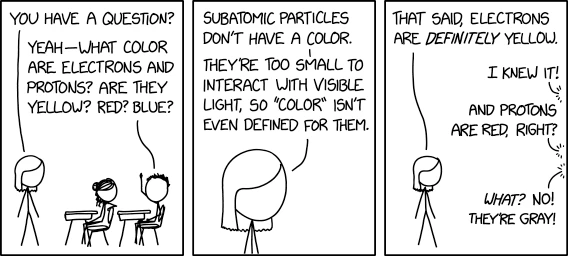
Relevant content: Conventional Current vs Electron Flow.
Animation shows how copper is a good conductor of electricity. Animation shows a 2 atom thick Copper conductor. Cu represents 29 Protons and 34 Neutrons of the nucleus and 28 electrons in the inner 3 shells. Only the valence shell is shown.
Animation shows how free electrons (red) move through circuit and copper atoms becoming ions when electrons become free and neutral when a free electron is captured.
EMF provides energy to release electrons. Positive copper ion will attract free electrons. Positive side of battery attracts free electrons and negative side of battery repels electrons.
Copper has 29 Protons, 34 Neutrons and 29 Electrons. The protons and neutrons form the Nucleus, around which electrons travel in an orbital fashion. The charge on the proton is the same as that of the electron. The net charge of all stable atoms is zero and therefore the number of protons and electrons must be equal.
Shell 1 can have 2 electrons, held by 29 protons. Shell 2 has 8 electrons, held by 27 protons. Shell 3 has 18 electrons, held by 19 protons. The valence shell, shell 4, has just 1 electron, held by 1 proton. Any electron can become a free electron, but it must overcome the attractive force of the appropriate level of protons (Shell 1: 29 protons; 2: 27; 3: 19; 4: 1). The higher the shell, the lower the energy required.
The single electron in the valence shell is far from the nucleus (in atomic terms) and it is not tightly held by the attractive force of the positive protons. This makes it free to move with only a little external energy.
This energy can be heat, light, applied force (hammer) or in the case of electrical conduction, electromotive force (EMF).
An EMF applied to complete conducting path (circuit) will cause copper atoms to release electrons. The copper atom becomes a Cu+ ion (positive charge), which attracts a free electron (negative charge). This is illustrated in the animation above where electrons are passed between copper ions.
This easy mobility of the outer electron accounts for the good conductivity of copper. Electrical conduction is simply the motion of electrons from one atom to another. Best Conductors: Silver (2,8,18,18,1); Copper (2,8,18,1); Gold (2,8,18,32,18,1) and Aluminum (2,8,3). The best conductors have 1 electron in the valence shell.
Limitations: Scale - 1 A of current is the flow of 6.24 × 1018 electrons. To get that many electrons to flow, significantly more copper atoms are required. Distance travelled - more atoms mean more possibilities for free electrons, so individual electrons may only move mm, but it is the net flow of all electrons, which is current. Bohr model - this explanation is very simplistic and relies on a 2 dimensional model of a three dimensional world we can not see. Animation - simulations are not perfect and it could be argued that it is via the imperfections learning is achieved. So a conductor 2 atoms thick is unrealistic and a pass the electron parcel from atom to atom approach is unrealistic, but the animation does illustrate the process.
Last updated: Jan 8, 2025.